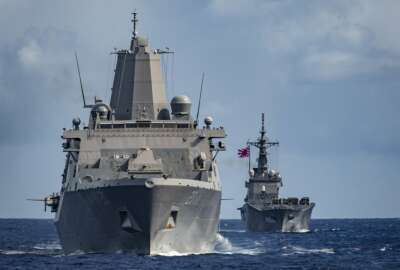
Navy contract spending jumps 30% in April amid coronavirus pandemic
The Navy Department's acquisition boss says the pandemic has helped to drive efficiencies into the contracting system, and many of them will need to become a la...
The federal contracting community has gotten used to seeing major upticks in contract outlays in the last couple months of the fiscal year. But for the Department of the Navy, April’s numbers rivaled those figures: Contract obligations this month are already up 30% compared to the same period a year ago, and almost double the figures from April 2018.
To be sure, the coronavirus pandemic was a big factor in the increase in dollars-on-contract. Like most other parts of the government, the Navy and Marine Corps are spending a lot to respond to the pandemic itself and to keep vulnerable parts of their supply chains afloat.
But that’s not the whole story, said James Geurts, the assistant secretary of the Navy for research, development and acquisition. The Navy Department’s ability to get cash out the door more quickly is also the result of reform efforts that have been underway for the last two-and-a-half years and emergency planning that predated the COVID crisis.
“I’m seeing some remarkable efficiencies,” he told reporters on a conference call Tuesday. “I think a lot of that is getting rid of layers of bureaucracy that weren’t needed. Some of it is also creating better partnerships with industry so that we can leverage cost and pricing data we already have, and we don’t have to send out an RFP and get a proposal back just to confirm that data. And some of it is just a continued sense of urgency and mission focus.”
As of Tuesday, the Department of the Navy had obligated $96.9 billion toward contracts in April, compared to $74.7 billion in April of 2019, even though more than 95% of its contracting workforce is working remotely. During the same month, those acquisition professionals also increased their use of distance learning for ongoing workforce development by more than 65%.
Read more: Defense News
Geurts said many of those “efficiencies” were born of necessity because of the pandemic, but there’s no good reason the changes the DON has made shouldn’t become part of the fabric of how its acquisition system operates.
“I think all of these are relatively sustainable activities,” he said. “I want to come out of this in a place where what we’re doing is now the standard — not crisis behavior or point-in-time behavior. “If we can make it the standard, we can leverage that efficiency to give us more resilience and to allow us to then recap that increased business tempo into products and services for the warfighter.”
In some instances, the Navy had already been thinking through ways to accelerate the contracting process and its cash outlays, but the pandemic provided a major incentive to implement those policies right away.
For example, Naval Sea Systems Command decided to release nearly $600 million in pending contractor payments it had been holding back. NAVSEA generally retains 10 percent of the dollar value of new ship construction or ship repair contracts until it’s satisfied the job has been done adequately.
“We were already moving toward reducing that because we found it not to be a terribly effective tool in the long run, and that we could use other tools to ensure that the work was completed and we had warranties on the work,” Geurts said. “We had already been moving down that path experimentally. But we thought it was in everybody’s best interest to move to that quickly, particularly because a lot of that retention had an overly-large impact on mid-sized and small subcontractors. And we are only as strong as our industrial base.”
The DON is also speeding up its use of Small Business Innovation Research (SBIR) and Small Business Technology Transfer (STTR) programs to keep funding flowing to the smaller firms it needs for R&D work. The Office of Naval Research announced this week that it will open up $30 million in rapid funding via a broad agency announcement; ONR plans to spend $250 million through the same BAA over the next 90 days.
Read more: Contracting News
But Geurts said he believes the Navy’s ability to reorient its contracting apparatus quickly in response to the pandemic is largely attributable to a reform initiative the Navy Department began in 2017. The adjustments are comprised of what he calls the “Four Ds:” Decentralized execution, differentiation of work, digitization of operations, and development of talent.
“I tend to be lucky more than smart, but in hindsight, those strategies are what allowed us to pivot very quickly to operating in this kind of unplanned contingency,” he said. “We decentralized so that the workforce understood intent in a culture of trust — we trusted them to make the right decision and we de-layered. In a crisis, that’s just gold. Digitizing the work has been money, because if we had not figured that out we would have never been able to operate with efficiency in a massively distributed workforce. We’ve also developed that workforce so that they have the confidence, and I have the confidence, to allow them to run at speed.”
Copyright © 2024 Federal News Network. All rights reserved. This website is not intended for users located within the European Economic Area.
Jared Serbu is deputy editor of Federal News Network and reports on the Defense Department’s contracting, legislative, workforce and IT issues.
Follow @jserbuWFED





